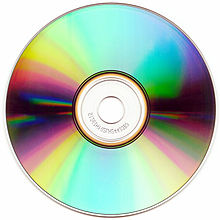
Back Laserskyf Afrikaans Compact Disc ALS ሲዲ Amharic Disco compacto AN قرص مضغوط Arabic ܩܘܪܨܐ ܚܠܝܨܐ ARC Discu compautu AST CD Azerbaijani سیدی AZB Compact Disc BAR
 | |
 The readable surface of a compact disc includes a spiral track wound tightly enough to cause light to diffract into a full visible spectrum. | |
| Media type | Optical disc |
|---|---|
| Encoding | Various |
| Capacity | Typically up to 700 MiB (up to 80 minutes audio), 800 MiB (also up to 90 minutes audio), 870 MiB (and up to 99 minutes audio) |
| Read mechanism | 780 nm wavelength (infrared) semiconductor laser (early players used helium–neon lasers),[1] |
| Write mechanism | 780 nm wavelength (infrared) semiconductor laser in recordable formats CD-R and CD-RW, stamped in read-only formats |
| Standard | Rainbow Books |
| Developed by | Philips, Sony |
| Dimensions | Diameter: 120 mm (4.7 in) Thickness: 1.2 mm (0.047 in) |
| Usage | Audio and data storage |
| Extended from | LaserDisc |
| Extended to | |
| Released |
|
| Optical discs |
|---|
The compact disc (CD) is a digital optical disc data storage format that was co-developed by Philips and Sony to store and play digital audio recordings. It uses the Compact Disc Digital Audio format which typically provides 74 minutes of audio on a disc. In later years, the compact disc was adapted for non-audio computer data storage purposes as CD-ROM and its derivatives. First released in Japan in October 1982, the CD was the second optical disc technology to be invented, after the much larger LaserDisc (LD). By 2007, 200 billion CDs (including audio CDs, CD-ROMs and CD-Rs) had been sold worldwide.
Standard CDs have a diameter of 120 mm (4.7 in), and are designed to hold up to 74 minutes of uncompressed stereo digital audio or about 650 MiB (681,574,400 bytes) of data. Capacity is routinely extended to 80 minutes and 700 MiB (734,003,200 bytes), 90 minutes 800 MiB (838,860,800 bytes), or 99 minutes 870 MiB (912,261,120 bytes) by arranging data more closely on the same-sized disc. The Mini CD has various diameters ranging from 60 to 80 millimetres (2.4 to 3.1 in); they have been used for CD singles or delivering device drivers.
The CD gained rapid popularity in the 1990s, quickly outselling all other audio formats in the United States by 1991, ending the market dominance of the phonograph record and the cassette tape. By 2000, the CD accounted for 92.3% of the entire market share in regard to US music sales.[3] The CD is considered the last dominant audio format of the album era, as the rise of MP3, iTunes, cellular ringtones, and other downloadable music formats in the mid-2000s ended the decade-long dominance of the CD.[4]
The format was later adapted (as CD-ROM) for general purpose data storage and initially could hold much more data than a personal computer hard disk drive. Several other formats were further derived, both pre-pressed and blank user writable, including write-once audio and data storage (CD-R), rewritable media (CD-RW), Video CD (VCD), Super Video CD (SVCD), Photo CD, Picture CD, Compact Disc-Interactive (CD-i), Enhanced Music CD, and Super Audio CD (SACD) which may have a CD-DA layer.
- ^ Träger, Frank (5 May 2012). Springer Handbook of Lasers and Optics. Springer. ISBN 9783642194092.
- ^ "The Compact Disc (CD) is Developed". historyofinformation.com. Retrieved 9 February 2023.
- ^ "U.S. Music Revenue Database". RIAA. Retrieved 17 March 2024.
- ^ Lynskey, Dorian (28 May 2015). "How the compact disc lost its shine". The Guardian. ISSN 0261-3077. Retrieved 17 March 2024.